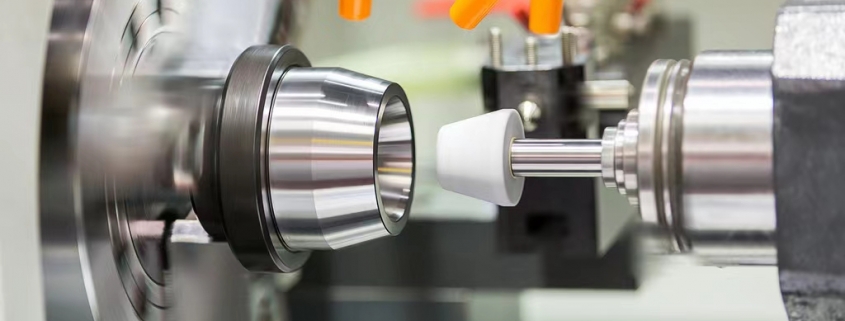Application of CNC Processing Technology in Custom Microphone Spare Parts
Application of CNC Processing Technology in Custom Microphone Spare Parts
CNC stands for computer numerical control, and it is the process of manufacturing parts with a variety of machine tools guided by computer instructions. These machines can be mills, lathes, routers, grinders or lasers.
The machining process starts with the design of a part in CAD software. Then, the CAD file is converted into G-code, which the CNC machine can understand.
Metal Earphones Housing
CNC (computer numerical control) is a manufacturing process where machines are controlled by code. This allows for precise control of machine speed, force, and materials. This enables large and bulky parts to be produced quickly and cost- effectively.
Many manufacturers are integrating CNC into their production processes to meet increasing demands for complex and detailed prototypes. This is a significant benefit for designers who may have limited capacity or resources, as CNC offers the ability to manufacture small-scale parts with incredible accuracy.
Sennheiser, an audio brand that specializes in high-end headsets and headphones, has used a 3D-printed amorphous zirconium material to create a shell for its upcoming IE 600 In-Ear Headphones. The company teamed up with Heraeus Amloy Technologies, a spin-off from the Heraeus Group and startup that deals in amorphous metals.
The earphones feature a shell made from the same amorphous zirconium that is used in the drill bits of NASA’s Mars rovers, which triples the hardness and bend resistance of high-performance steel. This ensures that the earbuds will last a long time, without any potential damage to the hardware inside.
Amorphous zirconium is a durable material that is also extremely lightweight. It can be shaped into any form and has high corrosion and rust-resistance properties. This is the reason why Sennheiser decided to use it in their new earphones, and the company claims that these are the first amorphous metal earbuds on the market.
Another advantage of using amorphous metal in an earphones shell is that it can be shaped into a unique design with tight tolerances, which can be difficult to achieve in other types of materials. The TruPrint 2000 Laser Metal Fusion technology, which is offered by TRUMPF, is an excellent option for producing complex and precise amorphous metal parts.
In addition to this, amorphous metals have a unique combination of strength, elasticity, and corrosion resistance that makes them an ideal choice for products like earbuds. Amorphous metals are also biocompatible, so they are an environmentally friendly alternative to conventional materials.
When designing a part for CNC, it is important to consider a number of factors, including the type of CAD software that will be used and file formats. This is particularly true for metals, which require different specifications than plastics. CAD files must be compatible with the CNC machine’s software before it can begin to produce the part.
Microphone Capsules
In the cnc world, the all-metal milling process is a dime a dozen but it’s the plastic machining techniques that will set your business apart from the pack. Having your custom component cut outs milled from a variety of materials can reduce the overall cost of your product to the tune of thousands of dollars per part. As with any manufacturing endeavor, selecting the right tool for the job is the key to success.
The best way to do that is to get in touch with a reputable supplier like Selection Hardware. From there, it’s all about getting your project in the hands of an experienced craftsman. Our seasoned experts will assist you in selecting the material for your new part and then guiding you through the entire machining process. We can then provide you with a quote, a spec sheet, a CAD drawing, and a delivery schedule.
Microphone Grilles
CNC processing (Computer Numerical Control) is a method of manufacturing components using machine tools such as lathes, mills, routers and grinders that run at speeds and force controlled by computer codes. These controls can be applied to all kinds of engineering thermoplastics and metals.
The first step in this process is to create a CAD design, which can then be translated into G-code that will allow the machine to operate at the desired speed and force.
Eventually, a human operator will test the part before it is produced to ensure that it performs according to expectations.
In most cases, microphone grilles are made of brass mesh, although other materials can be used as well. Depending on the application, the mesh may be finer or coarser in its specifications. In some situations, the mesh is layered several times to increase its effectiveness and durability.
A grille’s primary purpose is to provide varying degrees of protection from physical trauma and plosive gusts of air that can damage the mic capsule. These gusts can cause the diaphragm to break apart or overheat, which will result in unwanted rattling of the capsule.
Another purpose of grilles is to shield the diaphragm from moisture, which can also cause mic damage and deterioration. The acoustic foam inside some grilles will absorb moisture and help dissipate the effect of these gusts of air, preventing microphone capsules from overheating or breaking.
Grilles can also be designed with frequency response in mind, having specific spatial dimensions around the outer casing and the diaphragm of the microphone. This allows the user to maximize sound output while minimizing background noise.
Some microphones have grilles that are detachable from the microphone body, such as the Shure SM58. The grilles on these microphones are very robust, and are capable of absorbing the shock from hard hits while still being dent-resistant. This type of grille is most commonly seen on stage and live performance microphones, but some studio microphones have them as well. Integrated grilles are not as sturdy or durable, but are sometimes useful when the microphone needs to be mounted in an unconventional position.
Microphone Screws
CNC machining is one of the most commonly used manufacturing processes. It is a very precise process that can be used to create parts from a variety of materials, including metals and plastics.
The first step in cnc machining is to design the desired part in computer-aided design (CAD) software. This CAD software allows designers to create 2D vector or 3D solid part models. Once the design is complete, the model is exported to a CNC compatible file format such as STEP or IGES.
These CNC files are then interpreted by the machine and cut out the desired material using high–speed cutters. The CNC machine then repeats the cutting operation until the desired shape is achieved.
In addition to cutting out the desired material, cnc machines can also be used to make holes or other specific cuts. The number of axes that the machine uses to manipulate the material can vary, but typically three, four, or five are employed.
Another popular application for cnc processing technology is the creation of custom microphone spare parts. These are small pieces of metal that are designed to fit into a particular microphone. This can be useful for those who want to customize their microphones, and are willing to pay a little extra to get the right piece.
A shock mount is a unique type of microphone mount that partially isolates the microphone from vibrations. This helps reduce unwanted noise, such as traffic rumble or footsteps.
Shock mounts are available for a wide variety of different mics, and they can be found in a range of shapes and sizes. They are made from a durable material that offers superior strength and durability.
Microphone stands are another common type of microphone accessory. They have various adjustable lengths and are designed to allow a musician to place their microphone anywhere they like without taking up floor space. Boom arms are particularly convenient when musicians need to position their microphones higher than standard stands, and are available in fixed or telescoping lengths.
A microphone stand is an important accessory for any music maker, and these can be a lifesaver in the event of an accident. This is especially true when a singer needs to move their microphone quickly for an important live performance.
We are the trusted supplier of RODE microphones, therefore we have accumulated rich experience in fabricating microphone parts through CNC machines. If you have any spare parts want to be produced currently, contact us maybe we can have a chance to do business together.





